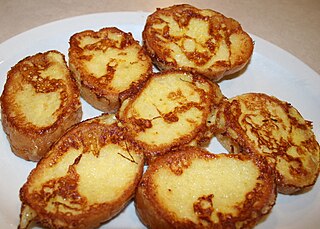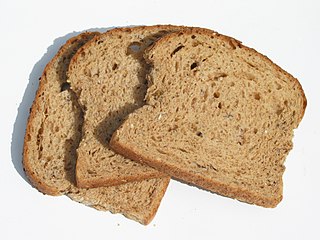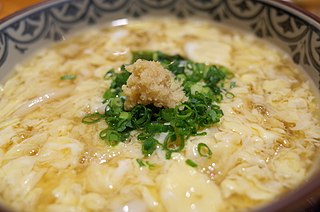
French toast is a dish of sliced bread soaked in beaten eggs and often milk or cream, then pan-fried. Alternative names and variants include eggy bread, Bombay toast, gypsy toast, and poor knights (of Windsor).

Russian cuisine is a collection of the different dishes and cooking traditions of the Russian people as well as a list of culinary products popular in Russia, with most names being known since pre-Soviet times, coming from all kinds of social circles.

Peasant foods are dishes eaten by peasants, made from accessible and inexpensive ingredients.

Tripe soup or tripe stew is a soup or stew made with tripe. It is widely considered to be a hangover remedy.

Levantine cuisine is the traditional cuisine of the Levant, in the sense of the rough area of former Ottoman Syria. The cuisine has similarities with Egyptian cuisine, North African cuisine and Ottoman cuisine. It is particularly known for its meze spreads of hot and cold dishes, most notably among them ful medames, hummus, tabbouleh and baba ghanoush, accompanied by bread.

Sopa de mondongo is a soup made from diced tripe slow-cooked with vegetables such as bell peppers, onions, carrots, cabbage, celery, tomatoes, cilantro, garlic or root vegetables. The dish is generally prepared in former Spanish colonies in Latin America, Caribbean, and in the Philippines.

Staling, or "going stale", is a chemical and physical process in bread and similar foods that reduces their palatability. Stale bread is dry and hard, making it suitable for different culinary uses than fresh bread. Countermeasures and destaling techniques may reduce staling.

Açorda is a traditional Portuguese dish composed of cubed or sliced stale bread with garlic, coriander, and poached eggs. It is a type of bread soup, although some variants have a consistency closer to that of a porridge.

Tharid is a bread soup that originates from Mecca, Saudi Arabia, an Arab cuisine also found in many other Arab countries. Like other bread soups, it a simple meal of broth and bread in this instance crumbled flatbread moistened with broth or stew. Historically, the flatbread used was probably stale and unleavened. As an Arab national dish it is considered strongly evocative of Arab identity during the lifetime of the Islamic prophet Muhammad. According to a widespread legend, this unremarkable and humble dish was the prophet's favorite food.

Soup is a primarily liquid food, generally served warm or hot, that is made by combining ingredients of meat or vegetables with stock, milk, or water. Hot soups are additionally characterized by boiling solid ingredients in liquids in a pot until the flavors are extracted, forming a broth. Soups are similar to stews, and in some cases there may not be a clear distinction between the two; however, soups generally have more liquid (broth) than stews.

Piti is a soup in the cuisines of the South Caucasus, its bordering nations, and Central Asia, and is prepared in the oven in individual crocks with a glazed interior. It is made with mutton and vegetables, infused with saffron water to add flavour and colour, all covered by a lump of fat, and cooked in a sealed crock. Piti is served in the crock, usually accompanied by an additional plate for "disassembling" the meat and the liquid part with vegetables, which may be eaten separately as the first and second (meat) course meal.

A meatball is ground meat (mince) rolled into a ball, sometimes along with other ingredients, such as bread crumbs, minced onion, eggs, butter, and seasoning. Meatballs are cooked by frying, baking, steaming, or braising in sauce. There are many types of meatballs using different types of meats and spices. The term is sometimes extended to meatless versions based on vegetables or fish; the latter are also commonly known as fish balls.

Bread soup is a simple soup that mainly consists of stale bread. Variations exist in many countries, and it is often eaten during Lent. Both brown and white bread may be used.

Swabian cuisine is native to Swabia, a region in southwestern Germany comprising great parts of Württemberg and the Bavarian part of Swabia. Swabian cuisine has a reputation for being rustic, but rich and hearty. Fresh egg pastas, soups, and sausages are among Swabia's best-known types of dishes, and Swabian cuisine tends to require broths or sauces; dishes are rarely "dry".

Egg drop soup, also known as egg flower soup, is a Chinese soup of wispy beaten eggs in chicken broth. Condiments such as black or white pepper, and finely chopped scallions and tofu, are commonly added to the soup. The soup is made by adding a thin stream of beaten eggs to the boiling broth in the final moments of cooking, creating thin, silken strands or flakes of cooked egg that float in the soup.

Mallorcan soup or Mallorcan dry soup is a typical dish in the gastronomy of the island of Mallorca. It is a rustic dish, often closer in texture to a casserole or very thick stew. It typically is eaten with a fork rather than a spoon.

















